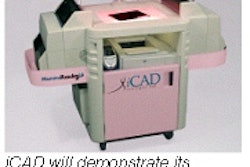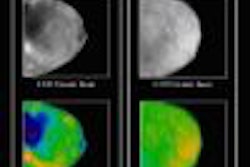A new study that assesses full-field digital mammography of dense breasts with FFDM systems from three different manufacturers found that varying the method of image processing didn’t measurably improve the accuracy of radiologists’ interpretations.
Published in the latest issue of Radiology, the seven-center study found no significant differences in interpretation accuracy between images processed using histogram-based intensity windowing (HIW), contrast-limited adaptive histogram equalization (CLAHE), and the three default preferred algorithms provided by FFDM manufacturers.
Still, the group that conducted the research isn’t giving up on the potential of digital mammography in dense breasts, which had been touted by earlier researchers due to the broader dynamic of digital detectors, and the range of image-enhancement options afforded by digital image processing.
"The application of different image processing algorithms may lead to different results; therefore, this study will be repeated with an additional three image processing algorithms applied to the same 201 digital mammograms," wrote Dr. Etta Pisano and colleagues. Pisano, along with lead author Eloida Cole, is from the University of North Carolina School of Medicine in Chapel Hill (Radiology, January 2003, Vol. 226:1, pp. 153-160).
In addition to North Carolina, the research was conducted at Massachusetts General Hospital in Boston; at the Hospital of the University of Pennsylvania, Philadelphia; University of Virginia, Charlottesville; Good Samaritan Hospital, West Islip, NY; University of Toronto, Ontario, Canada; and at Thomas Jefferson University Hospital, Philadelphia.
In their current report, the researchers found that lesion type (masses vs. calcifications) affected the specificity for radiologists reading images from a system manufactured by Fischer Imaging of Denver, and the AUC (area under the receiver operating characteristic curve) and sensitivity for radiologists reading images from a Lorad system (Lorad, Danbury, CT).
Using the Senographe 2000D system (GE Medical Systems, Waukesha, WI), the AUC, sensitivity, and specificity achieved by the radiologists was better for breast masses than for calcifications, but the differences didn’t achieve statistical significance.
The difference in the radiologists’ performance on masses vs. calcifications was expected in a study using digital mammography, the authors stated.
"As individual calcifications tend to be considerably smaller than masses, a reader’s ability to define the morphology of calcifications by using the standard four views, given spatial resolution constraints, may make it more difficult to assess them well," they wrote. "Clearly, the assessment of calcification morphology is improved with focal magnification techniques, which were not available to our readers."
With Fischer’s SenoScan, there was a higher specificity for interpretation of masses than for interpretation of calcifications (P = .0004). HIW was the best image-processing method for specificity, but the improvement didn’t reach statistical significance.
With the Lorad Digital Mammography System, the AUC and sensitivity were both better (P < .0001) for interpretation of masses than interpretation of calcifications across the three image processing algorithms. Again, HIW was the image processing method that led to the best performance, but not significantly.
The researchers noted that the lack of statistically significant differences between image processing methods could be attributable to an insufficient sample size to achieve the effect.
The overall sensitivity, specificity, and AUC values obtained in the study were also "somewhat lower than values published in the literature for screen-film mammography and digital mammography for screening populations," they wrote, adding that continuing the study will also allow the group to improve the research.
"Because careful control of lesion size and cancer stage was not maintained between the screen-film images used to establish baseline performance and the digital images, a direct comparison between performance with digital images and with screen-film images was not possible for the study documented here," the authors wrote. "Use of the screen-film mammograms obtained at the time of enrollment of patients in this study (i.e., the screen-film images were obtained at the same time as the digital images) will eliminate this limitation in the replication study currently underway."
By Tracie L. ThompsonAuntMinnie.com contributing writer
January 10, 2003
Related Reading
No compromise in breast image quality with lower FFDM dose, December 13, 2002
FFDM fares as well as screen-film for population-based breast screening, December 1, 2002
Innovative programs cut through mammography's crisis, October 17, 2002
U.S. to fund multicenter digital mammography study, September 5, 2001
Copyright © 2003 AuntMinnie.com



















